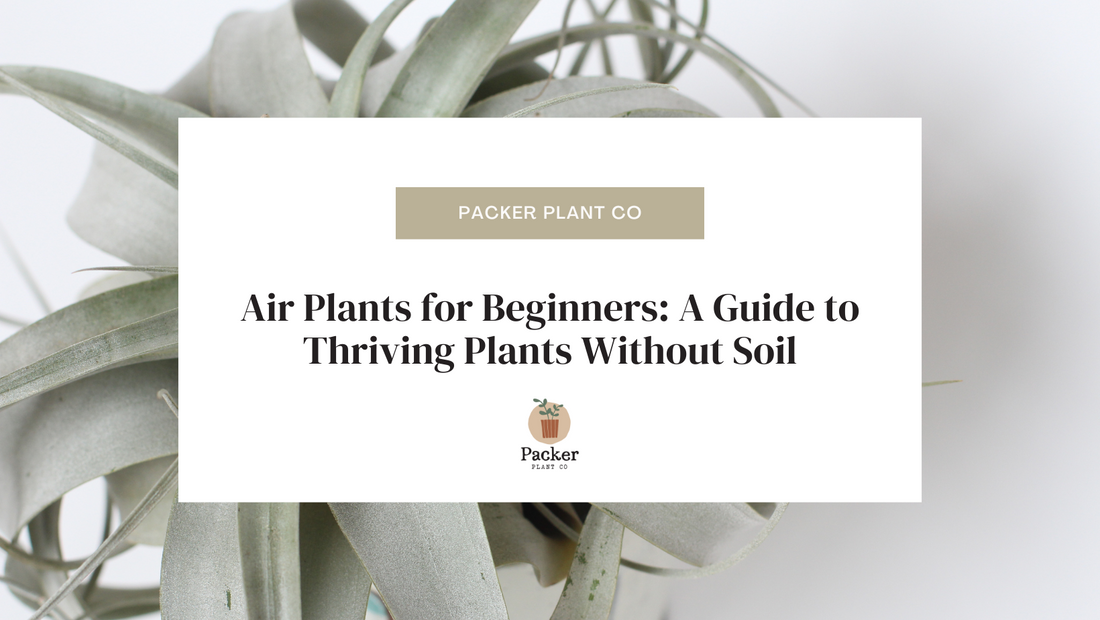Air plants, or Tillandsias, are a fascinating and low-maintenance option for both new and experienced plant owners. These unique plants don't need soil to grow, making them an excellent choice for anyone looking to add greenery to their home without having traditional potted plants. In this guide, we'll cover everything a beginner needs to know about air plants, from selecting the right species to caring for them. We'll also introduce you to our convenient air plant fertilizer spray, designed to keep your air plants healthy and vibrant.
What Are Air Plants?
Air plants belong to the genus Tillandsia and are part of the bromeliad family. They are epiphytes, which means they grow on other surfaces—like trees, rocks, or even buildings—rather than in soil. Air plants absorb water and nutrients through their leaves, making them distinct from most other plants that rely on roots for sustenance. This adaptability allows them to thrive in a variety of environments, making them an ideal choice for the indoors.
Choosing the Right Air Plant for Beginners
There are over 600 species of air plants, but not all are equally easy to care for. Here are a few beginner-friendly varieties:
-
Tillandsia Ionantha: One of the most popular air plants, the Ionantha is small, hardy, and changes color as it grows, offering a dynamic display of greens, pinks, and reds.
-
Tillandsia Xerographica: Known for its large, silvery leaves that curl gracefully, this air plant makes a stunning centerpiece and requires minimal care.
-
Tillandsia Caput-Medusae: With its tentacle-like leaves, this variety adds a whimsical touch to any space. It's also one of the hardiest air plants, making it perfect for beginners.
How to Care for Air Plants
Air plants are relatively low-maintenance, but they do have specific needs to thrive. Here's a simple care guide:
1. Lighting
Air plants thrive in bright, indirect light. Place them near a window with filtered sunlight or under fluorescent lights. Avoid direct sunlight, which can scorch their delicate leaves. If you're placing them in a room with less natural light, consider supplementing with a grow light to ensure they get the energy they need.
2. Watering
Unlike traditional plants, air plants don't need to be watered in the usual sense. Instead, they absorb moisture from the air. For beginners, the simplest way to water your air plant is to soak it in room-temperature water for 20-30 minutes once a week. After soaking, shake off any excess water and let the plant dry completely before placing it back in its holder. If you live in a particularly dry environment, misting your air plant with water in between soakings can help keep it hydrated.
3. Humidity
Air plants love humidity, so they thrive in bathrooms or kitchens where the air is naturally more humid. If your home is dry, especially in winter, consider misting your air plant more frequently or placing it near a humidifier.
4. Air Circulation
Good air circulation is essential for air plants to prevent rot. Ensure they are placed in an open area where air can circulate freely. Avoid placing them in enclosed terrariums unless they have adequate ventilation.
5. Fertilizing
While air plants can survive without fertilizer, they will thrive and grow more vigorously if provided with the right nutrients. This is where our air plant fertilizer spray comes in handy. Designed specifically for air plants, our fertilizer spray is easy to use—simply spray it on your air plant every other week in place of watering. The balanced formula provides essential nutrients that promote healthy growth and vibrant colors, ensuring your air plant stays in top condition.
Styling Your Air Plant
One of the joys of owning air plants is their versatility in styling. Here are a few creative ideas to display your air plants:
-
Terrariums: While air plants don't need soil, they look stunning in glass terrariums. Add some decorative rocks, moss, or sand to create a mini landscape.
-
Mounted on Wood: Attach your air plant to a piece of driftwood or bark for a natural, rustic look. This mimics their natural habitat and creates an eye-catching wall display.
-
Hanging Globes: Air plants are light and can be hung in glass globes or macramé hangers, adding greenery to any space without taking up surface area.
-
Shells and Sea Urchins: For a beachy vibe, place your air plants in large seashells or empty sea urchin shells. This creates a unique and natural display that complements coastal decor.
Common Mistakes to Avoid
While air plants are relatively easy to care for, there are a few common mistakes that beginners should avoid:
-
Overwatering: Air plants can rot if they're left sitting in water for too long. Always ensure they dry completely after soaking.
-
Insufficient Light: While air plants can tolerate low light, they won't thrive without enough light. Make sure they receive bright, indirect light to keep them healthy.
-
Using Tap Water: Tap water can contain chlorine or other chemicals that are harmful to air plants. If possible, use rainwater, distilled water, or let tap water sit out for 24 hours to allow the chemicals to dissipate before using it to soak or mist your air plant.
Conclusion: Thriving with Air Plants
Air plants are a fantastic choice for beginners looking to add greenery to their homes without the fuss of soil and pots. With the right care and attention, your air plants can thrive and bring a touch of nature into any space. Remember to use our air plant fertilizer spray every other week to keep your plants healthy, vibrant, and growing strong. Whether you choose to display them in a terrarium, mounted on wood, or in a hanging globe, air plants are sure to enhance your home with their unique beauty.

If you liked this blog post, make sure you're following us on social media for more!

